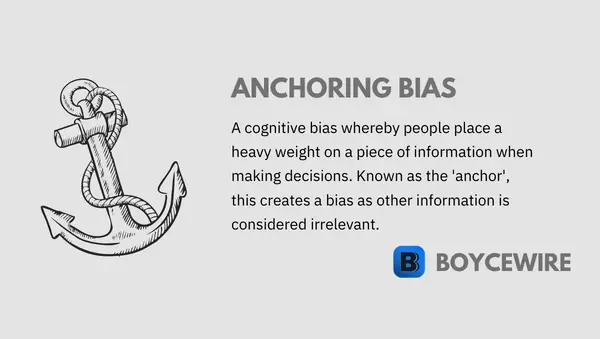Anchoring Bias: Definition & Examples

What is Anchoring Bias
Anchoring is a cognitive bias where a specific piece of information is relied upon to make a decision. In other words, one factor is considered above all else in the decision-making processes. For example, used car salesmen often use ‘anchors’ to start negotiations. So rather than ask for $3,000 for the car, they ask for $5,000. That way, when he cuts the price of the car, it seems like we are getting a better deal. The $5,000 is the anchor. So our expectations are set around the initial price point.
An important part of anchoring bias is the tendency for the first piece of information to be used as the ‘anchor’. This ‘anchor’ is the reference point for future decisions, expectations, or judgments.
Key Points
- Anchoring bias occurs when one piece of information is given greater importance than others.
- This may be the first piece of information in a sequence.
- Anchoring occurs to reduce the amount of cognitive load placed on our brains.
Anchoring Bias Explained
Anchoring bias is used in order to come to a more logical decision. However, it can, in fact, have the opposite effect. The reasoning is quite simple. When we make a decision, particularly without prior evidence, we often assign a strong level of significance to the first piece of information we see.
We use such information to make what our minds think is a logical estimate based on limited information. However, the effect can also occur when information is more available. Even though we may have a suitable level of detail to make an informed decision, the ‘anchor’ can have an overwhelming effect on our decision.
Take the stock market for example. There is a tendency for investors to ‘anchor’ their valuation to the stock price. The stock price is the first thing they see before fundamentals such as historical profitability or revenue growth. So their expectations are intrinsically linked to the initial value they see. Whether consciously or sub-consciously.

The current stock price will affect investors’ valuation of the stock. When analyzing the true value of a company, a low current stock price leads to lower valuations, whilst high stock prices lead to the opposite.
It is for this reason that Warren Buffett ignores the share price and instead looks purely at the fundamentals. He simply doesn’t want to be influenced by it and instead comes to an unbiased valuation.
Examples of Anchoring Bias
1. Negotiations
Negotiations are a classic example of anchoring bias. In fact, research from Harvard University demonstrates the significant effects it can on negotiations. Often, we tend to wait for the other party to make the first offer. However, it has been proven that this can in fact skews the negotiation.
The research states that in situations of great ambiguity and uncertainty, first, offers have a strong anchoring effect—they exert a strong pull throughout the rest of the negotiation. In other words, the first offer sets the ground for reasonable negotiation. Higher first offers are more likely to lead in higher sale prices than lower first offers.
If we take an example of a car salesman. He is trying to sell a Ford Focus for $20,000. The customer comes in and decides they like the car and is willing to pay up to $15,000. After discussing the details of the car, the salesman makes an offer to the customer of $22,000. This is the anchor.
The customer hears the $22,000 price and thinks ‘oh, that’s way out of my price range’. However, at the same time, the customer has anchored their valuation of the car to $22,000.
The salesman then says ‘We can do a deal especially for you, we can go down to $19,000 if you buy today’. ‘That’s an excellent deal, it’s a bit out of my price range, but I can’t miss out on this offer’, the customer replies.
As the customer anchored their price expectation of the car at $22,000, anything underneath that seems like an excellent deal.
2. In the Courtroom
Often, we see judges award different sentences for almost identical crimes. These can differentiate by years or millions of dollars. The reason is linked back to anchoring bias.
When an initial demand or recommended sentence is suggested, it has an impact on the judge’s final verdict. In fact, a paper by Eyal Peer & Eyal Gamliel found that judges were susceptible to recommended or demanded sentences suggested by the prosecutor.
Further research by Birte Englich and Thomas Mussweiler shows that when presented with unrealistically high sentencing options, it led them to give longer sentences. The research also found that even more experienced judges were susceptible to anchoring bias. Therefore, the main conclusion to be made is that even though other information is available, judges, as well as others, are susceptible to anchoring.

3. Showroom Sales
One common method showroom’s use to encourage buyers is to put the most expensive and attractive cars at the front. That way, not only are customers drawn in, but they see the highest price points first. This is crucial!
When the customer walks in, they may see a luxury car priced at $40,000. Way out of their price range, but the anchor is placed. Every other car is going to seem cheaper in comparison.
In turn, the higher price point of the anchor will tend to increase the willingness to pay. By contrast, showing the customer the cheapest car as they come in may suggest that they are affordable. A $20,000 initial price point for the ‘anchor’ car will reduce the willingness to pay. This is because this is set as the anchor by which all other cars are compared to.
4. Marketing
Anchoring bias in marketing and advertising is a key tool used to increase sales. There are a number of key techniques that are used to take advantage of the anchoring bias.
The first one is to make the product artificially high, but have frequent ‘discounts’. A number of grocery stores do this regularly. By having a high ‘anchor’ price, it makes the discounts seem like a good deal.
We also have restaurants employing anchoring techniques. For instance, New York based restaurant Serendipity 3, introduced the “haute dog”, costing $69 and making it the most expensive in the world. This is designed to be the anchor. When the customer comes in and sees a $69 hotdog, a $17.95 hamburger and fries seem cheap.
The restaurant also release a $1,000 Golden Opulence Sundae which was available with 48 hours’ notice. Only one was sold, but it helped boost sales of cheaper desserts such as a $15.50 fruit and fudge.
Anchoring Bias Experiment
Experiment #1
Anchoring bias originates from research conducted by Amos Tversky and Daniel Kahneman in 1974. In their paper ‘Judgment under Uncertainty: Heuristics and Biases’, they conducted an experiment on two groups of high school children. The first group was asked to calculate the following calculation:
8 x 7 x 6 x 5 x 4 x 3 x 2 x 1
The second group was given the equation:
1 x 2 x 3 x 4 x 5 x 6 x 7 x 8
Both groups were given 5 seconds to come to an answer. The study showed that when under time constraints, people estimate the product by extrapolation or adjustment. In other words, they use the ‘anchor’ to help make an estimate. So in this experiment, it tends to be the first number that influences the end result.
The results showed that the first group estimated the answer to be 2,250. By contrast, the second group estimated a much lower figure at 512. So when presented with the higher figure first, the group estimated a higher figure, but when presented with the lower figure first, a lower figure was estimated.
Experiment #2
In a separate study, Tversky and Kahneman asked subjects to estimate the answer to how many African countries were in the United Nations. They were asked to give the answer as a percent, but first, they had to spin a wheel. The wheel itself was destined to land on 10 or 65.
They were then asked to say whether the figure was higher or lower than the number on the wheel. In turn, they were also asked to give an estimated percentage.
Those who had the wheel land on 10 estimated that 25 percent of African countries belonged to the United Nations. By contrast, those who landed on 65 estimated the figure to be much higher at 45 percent.
The conclusion was self-evident. Those who received a higher initial figure (the anchor), guessed at a higher rate as they used it to gauge their estimate, most likely in a subconscious way.
How to Avoid Anchoring Bias
Step 1. Acknowledgment
The first step to avoiding anchoring bias is to acknowledge it exists. If you have come this far, that’s a good step. By acknowledging that our minds are susceptible to such influences, we are less likely to fall into the bias trap that is set.
So instead of going into a negotiation and letting the other party drop the anchor and make the first offer, you are able to beat them too it.
Step 2. Step back and take your time
Unless absolutely necessary, it is important for you to take time over your decision. In doing so, you will be able to step back, acknowledge any anchoring bias, and look at the bigger picture.
By taking your time in the decision-making process, you are able to collect more information and dilute the effect that the anchor has. Whilst in a store, there may be an offer of 75 percent off. However, what looks like a good deal may just be the industry norm. Every other store may sell at the same price, if not cheaper.
This is why it is important to step back, acknowledge the information is limited and thereby acquire for information. Is that hairdryer really a good deal at 75 percent off? Or is it even cheaper in the store down the road?
Step 3. Beat the Anchor
Once we understand how and why the anchor exists, it is important to counteract it. We can use our awareness of its existence to make better-formed decisions. For instance, rather than looking at the stock price first, look at the company reports and fundamentals and create an estimated value that is independent of the current stock price.
In addition, you may want to start the negotiation so as to drop the anchor first. That way, you are able to dictate the negotiations in your court. Whilst you may not get the desired result, the final price will be more in your favour.
Related Topics
Anchoring Bias FAQs
You see a stock for $5 and buy 1,000 of them. However, after a few months, the price falls to $4.50. ‘Those are worth $5, so I’ll keep hold of them’ you tell yourself. Yet the price continues to fall down to $3. Nevertheless, you may still believe they are worth $5 (the anchor value), despite the companies continued poor performance.
Anchoring bias can benefit decision making as it can help us make reasonable estimates based on limited information. However, it can also lead to significant mistakes. When we rely too heavily on one piece of information, it restricts our ability to think logically and consider other aspects that need to be considered. For example, stock market investors may become fixated on short term fluctuations and anchor their expectations to the current price. However, a bad business will always produce bad returns in the long-run.
Anchoring bias was originally coined by Amos Tversky and Daniel Kahneman in a 1974 paper (“Judgment under Uncertainty: Heuristics and Biases”)
About Paul
Paul Boyce is an economics editor with over 10 years experience in the industry. Currently working as a consultant within the financial services sector, Paul is the CEO and chief editor of BoyceWire. He has written publications for FEE, the Mises Institute, and many others.

Further Reading
 Embezzlement - Embezzlement is the act of fraudulently misappropriating or stealing funds or assets entrusted to one's care, often done by an…
Embezzlement - Embezzlement is the act of fraudulently misappropriating or stealing funds or assets entrusted to one's care, often done by an…  Expected Value Formula - The expected value formula is a mathematical calculation used to estimate the average outcome of a random variable, taking into…
Expected Value Formula - The expected value formula is a mathematical calculation used to estimate the average outcome of a random variable, taking into…  Efficient Frontier - Table of Contents What is Efficient Frontier? Understanding Construction Optimal Portfolios Applications Limitations Examples FAQs Efficient Frontier: Definition, Limitations &…
Efficient Frontier - Table of Contents What is Efficient Frontier? Understanding Construction Optimal Portfolios Applications Limitations Examples FAQs Efficient Frontier: Definition, Limitations &… 